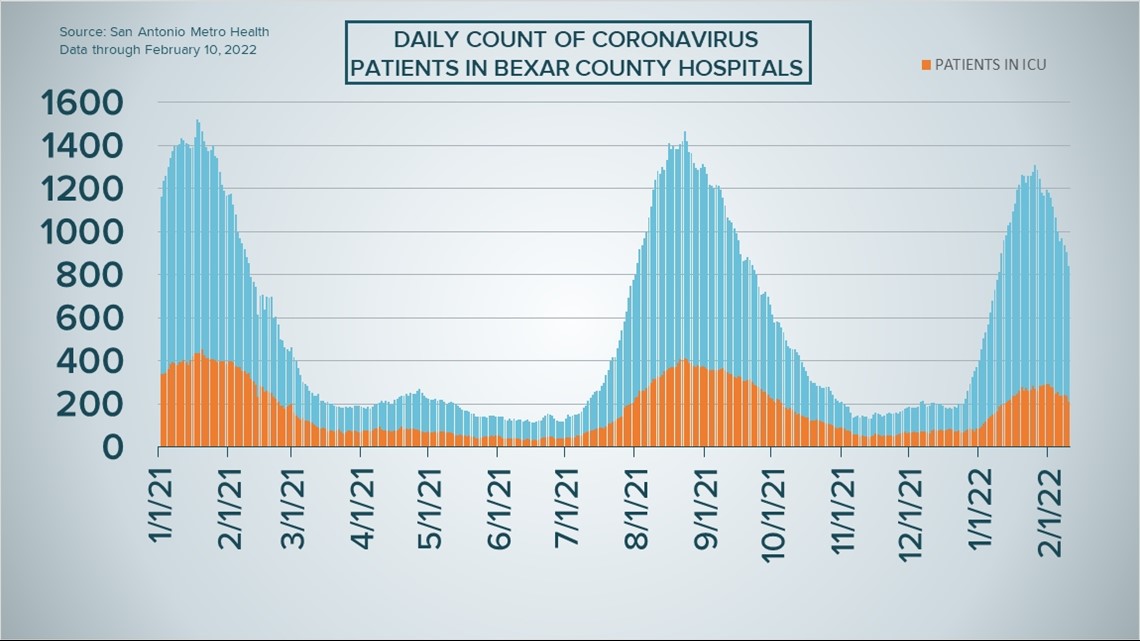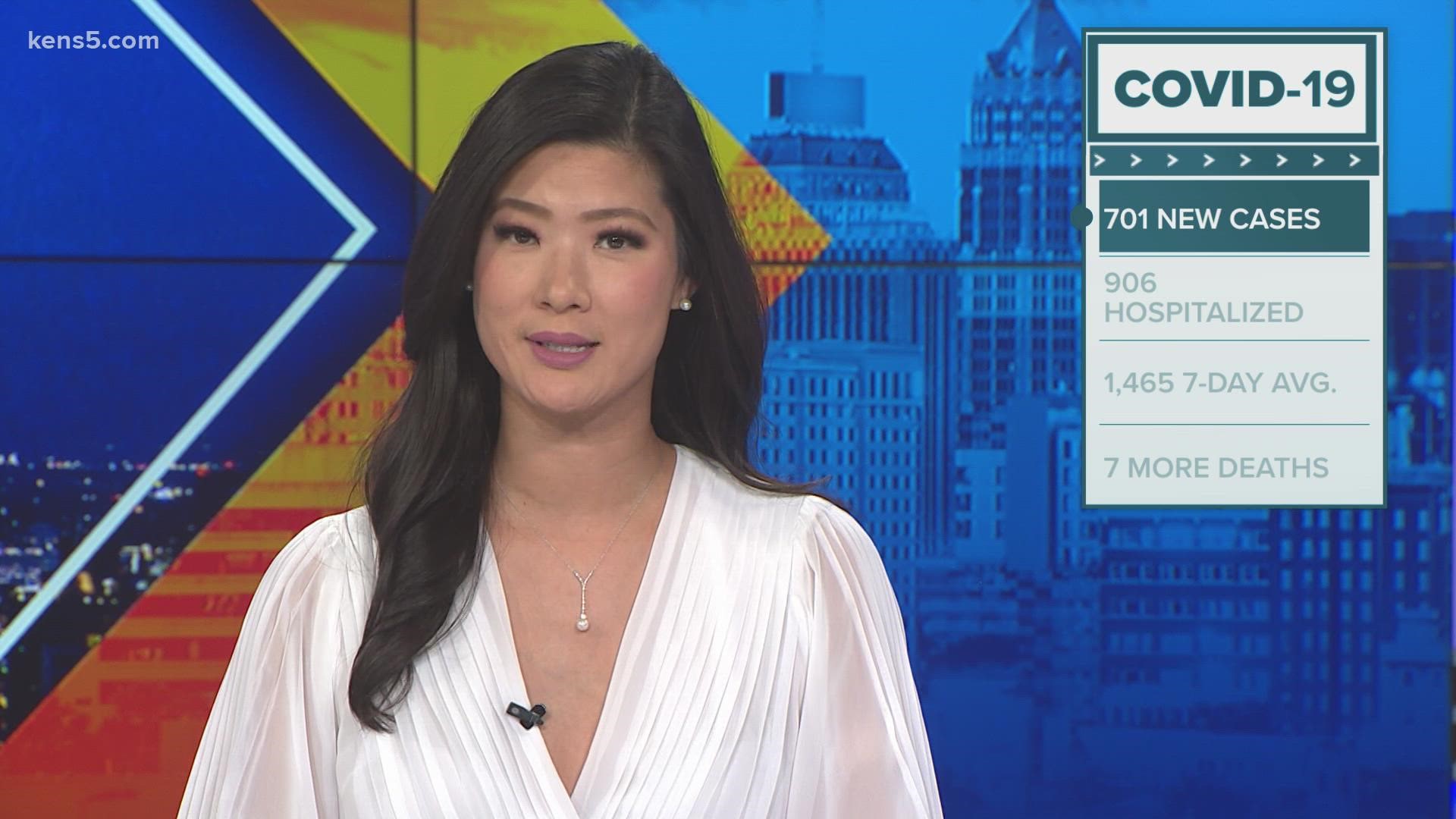SAN ANTONIO — For the third day in a row, Bexar County health authorities reported fewer than 1,000 new COVID-19 cases Thursday after tallying no such days in 2022 prior to Tuesday.
Thursday's total of 903 additional infections brought the seven-day case average down to 1,345—the lowest it's been since New Year's Day, just before the worst surge of the pandemic sent the San Antonio area's numbers skyrocketing.
In another sign that the highly contagious omicron variant's grip may be loosening is continuously decreasing hospitalization levels. On Thursday there were 840 patients receiving treatment for COVID-19 symptoms in local facilities, which is the fewest since Jan. 10.
All but once in the last week have the number of Bexar County hospitalizations dropped. Since last Thursday, the number of local patients has gone down by 24.7%. Of those 840 patients currently hospitalized, 212 are in intensive care and 109 are using ventilators to help them breathe.
But additional virus-related deaths were also reported by Metro Health for a fourth straight day on Thursday, with six new fatalities. In all, 5,178 county residents have died from COVID-19 complications, while more than 511,000 have been diagnosed.
On Thursday Northside ISD officials announced they were ending a weeks-long mask mandate, effective Monday, while in Austin students at the University of Texas are petitioning for additional pandemic safety guidelines as omicron continues to be a threat.
Meanwhile, last week a San Antonio-based doctor testified to Congress about the potential effects of long-term COVID the country's health care infrastructure.
How Bexar County is trending




Vaccine Progress in Bexar County
The following numbers are provided by San Antonio Metro Health. A full breakdown can be found here.
- 1.738 million eligible Bexar County residents have received at least one dose of the coronavirus vaccine as of Thursday, Feb. 10.
- 1.413 million eligible Bexar County residents are fully vaccinated as of Thursday, Feb. 10.
The CDC states that "when a high percentage of the community is immune to a disease (through vaccination and/or prior illness)," that community will have reached herd immunity, "making the spread of this disease from person to person unlikely."
The City of San Antonio breaks down the vaccination rates by zip code on Metro Health's Vaccination Statistics page.
Coronavirus in Texas
The total number of coronavirus cases in the state since the pandemic began grew by 15,598 on Thursday, according to the Texas Department of State Health Services. That total includes 11,643 new confirmed cases and 3,955 new probable cases. More details can be found on this page.
Thursday's figures bring the total number of Texans diagnosed with COVID-19 to more than 6.423 million.
An additional 305 Texans have died from virus complications, meanwhile, raising the statewide death toll to 80,310.
Coronavirus symptoms
The symptoms of coronavirus can be similar to the flu or a bad cold. Symptoms include fever or chills, cough, shortness of breath or difficulty breathing, fatigue, muscle or body aches, headache, new loss of taste or smell sore throat, congestion or runny nose, nausea or vomiting, and diarrhea, according to the Centers for Disease Control.
Most healthy people will have mild symptoms. A study of more than 72,000 patients by the Centers for Disease Control in China showed 80 percent of the cases there were mild.
But infections can cause pneumonia, severe acute respiratory syndrome, kidney failure, and even death, according to the World Health Organization. Older people with underlying health conditions are most at risk.
Experts determined there was consistent evidence these conditions increase a person's risk, regardless of age:
- Chronic kidney disease
- COPD (chronic obstructive pulmonary disease)
- Obesity (BMI of 30 or higher)
- Immunocompromised state (weakened immune system) from solid organ transplant
- Serious heart conditions, such as heart failure, coronary artery disease, or cardiomyopathies
- Sickle cell disease
- Type 2 diabetes
- The CDC believes symptoms may appear anywhere from two to 14 days after being exposed.
Human coronaviruses are usually spread...
- Between people who are in close contact with one another (within about 6 feet).
- Through respiratory droplets produced when an infected person coughs, sneezes or talks. These droplets can land in the mouths or noses of people who are nearby or possibly be inhaled into the lungs.
- Some recent studies have suggested that COVID-19 may be spread by people who are not showing symptoms.
Help stop the spread of coronavirus
- Stay home when you are sick.
- Eat and sleep separately from your family members
- Use different utensils and dishes
- Cover your cough or sneeze with your arm, not your hand.
- If you use a tissue, throw it in the trash.
Find a Testing Location
City officials recommend getting a COVID-19 test if you experience fever or chills, cough, shortness of breath or difficulty breathing, fatigue, muscle or body aches, headache, new loss of taste or smell, sore throat, congestion or runny nose, nausea or vomiting, or diarrhea.
Here's a Testing Sites Locator to help you find the testing location closest to you in San Antonio.
Latest Coronavirus Headlines
- No, the alpha and beta variants of the coronavirus aren’t circulating in the US
- 'We failed on the social science': US reaches 900,000 COVID-19 deaths
- NISD lifting temporary indoor mask mandate that took effect in January
- Haven't gotten your free COVID tests in the mail yet? Here's what you need to do
- COVID-19 truck blockade in Canada shuts down Ford plant
- Doctors are warning parents that your kids could have croup-like symptoms while having COVID
- Dallas Zoo says 5 gorillas have tested positive for COVID-19
- Prince Charles tests positive for COVID-19 again

